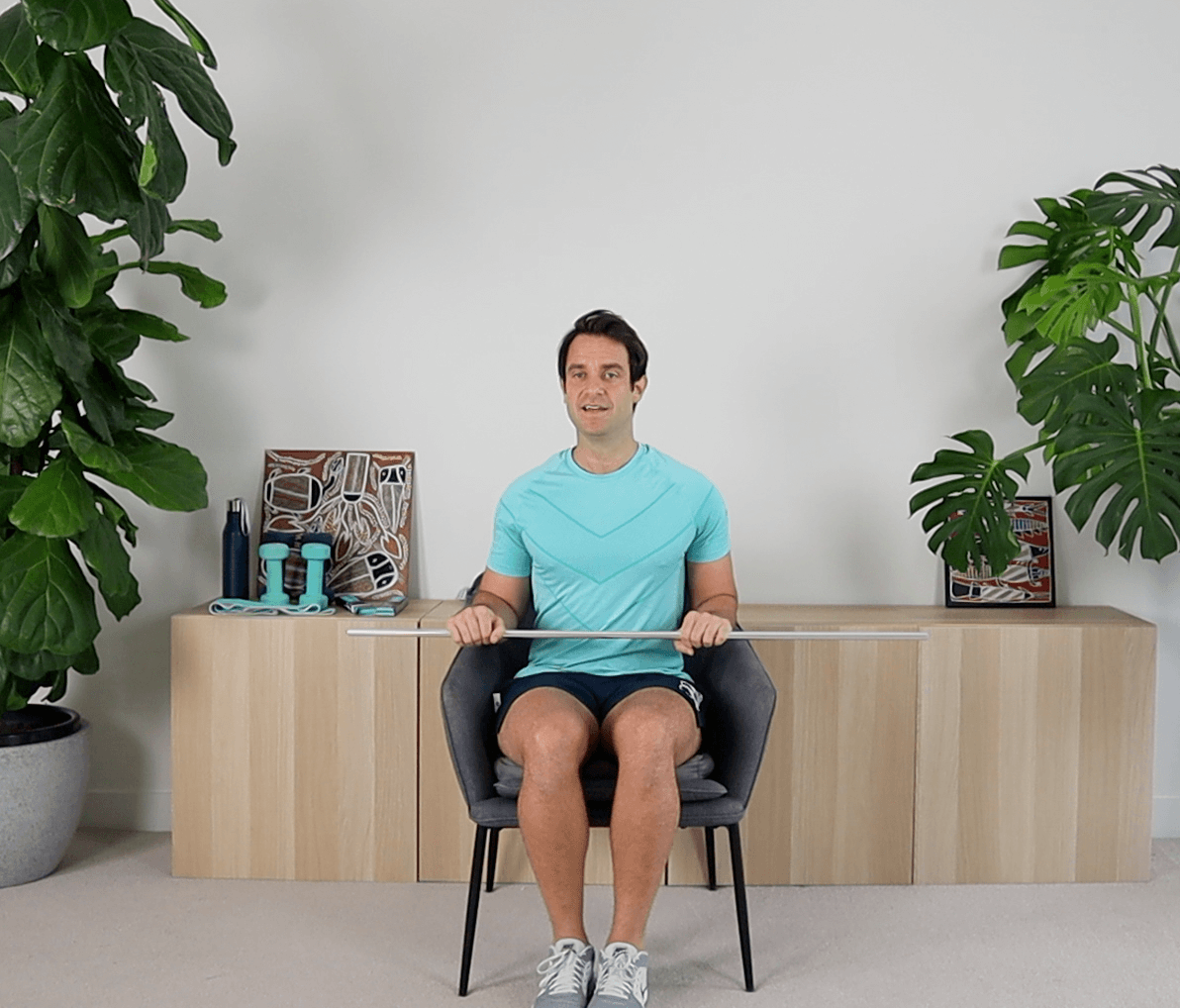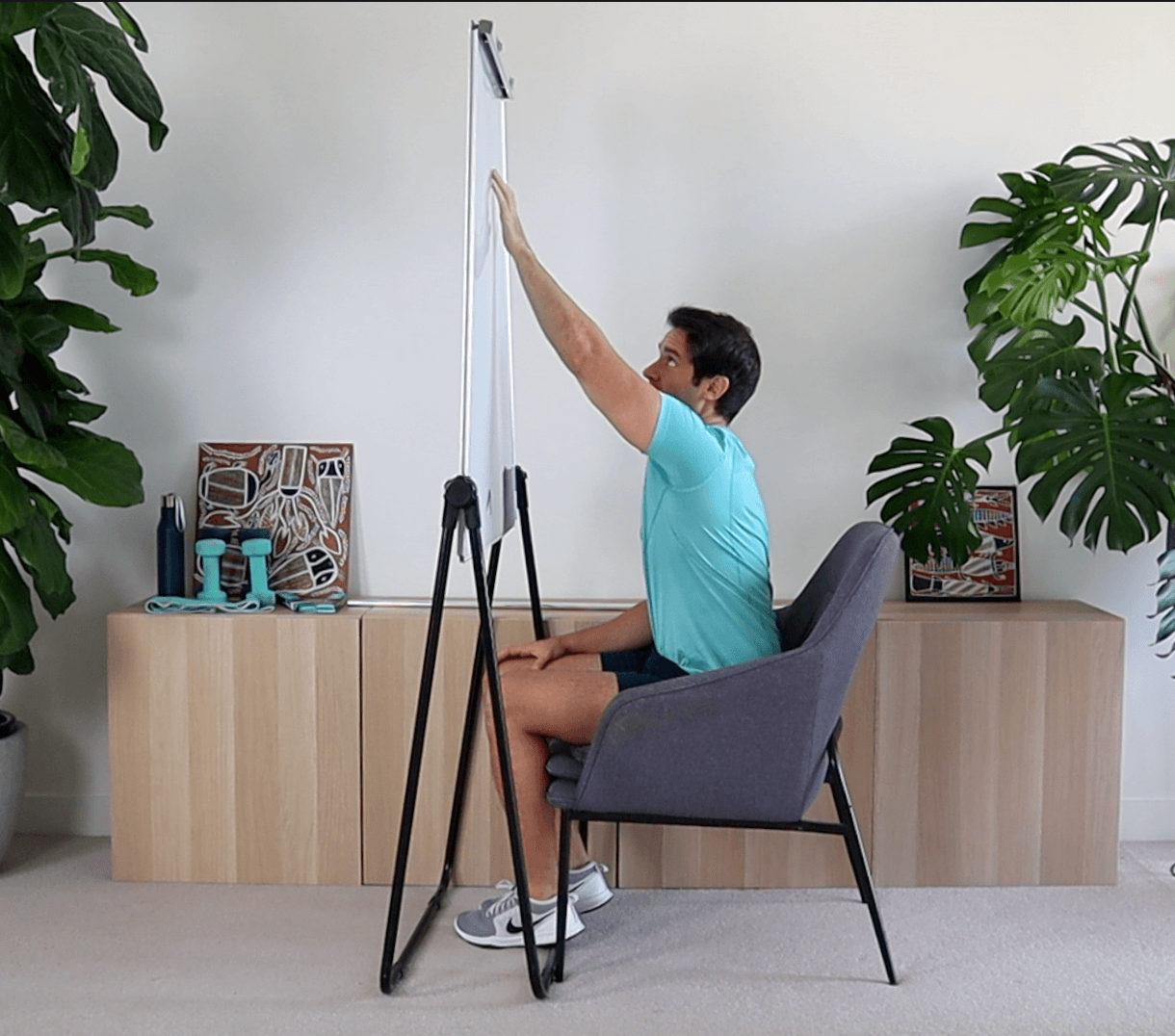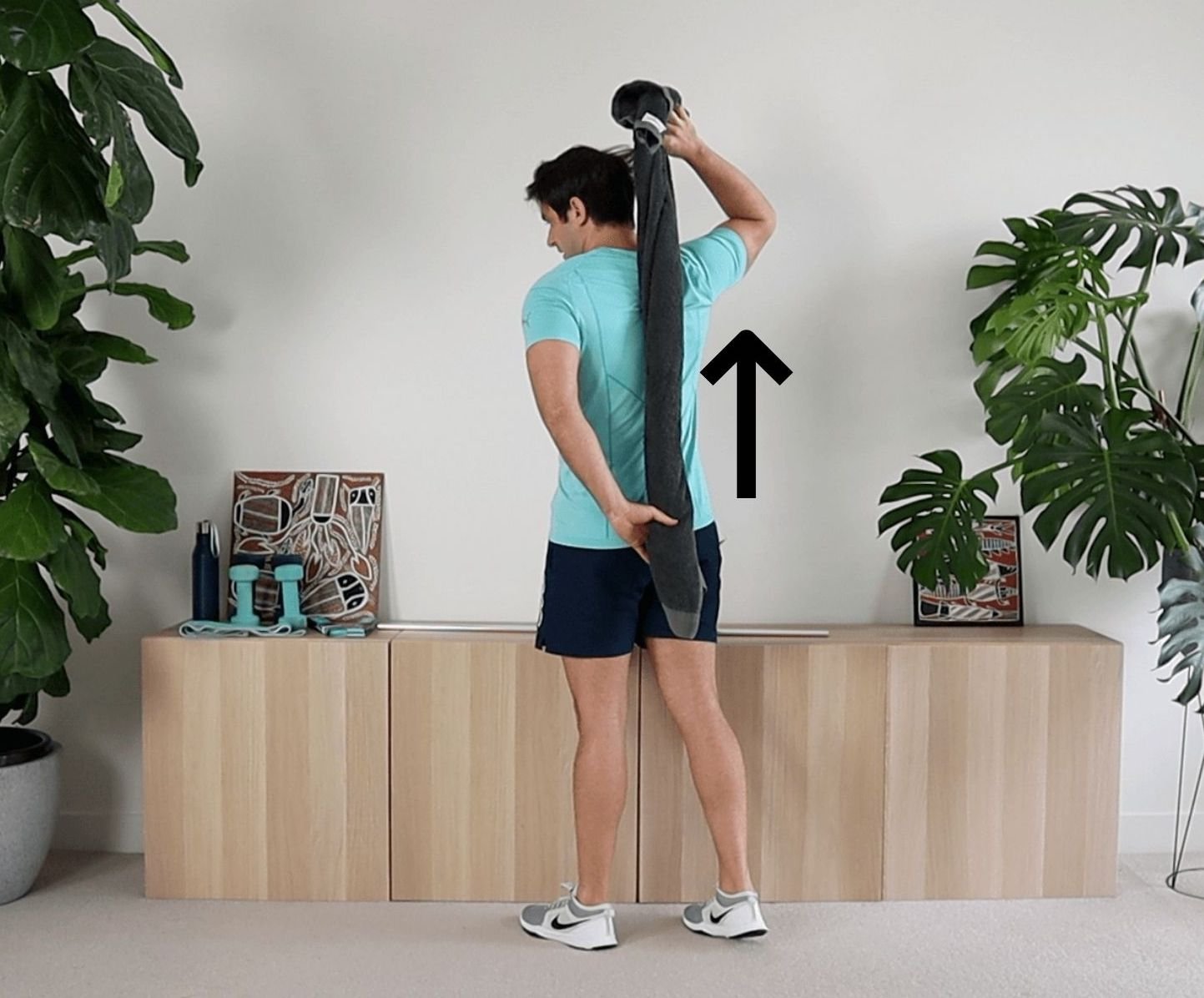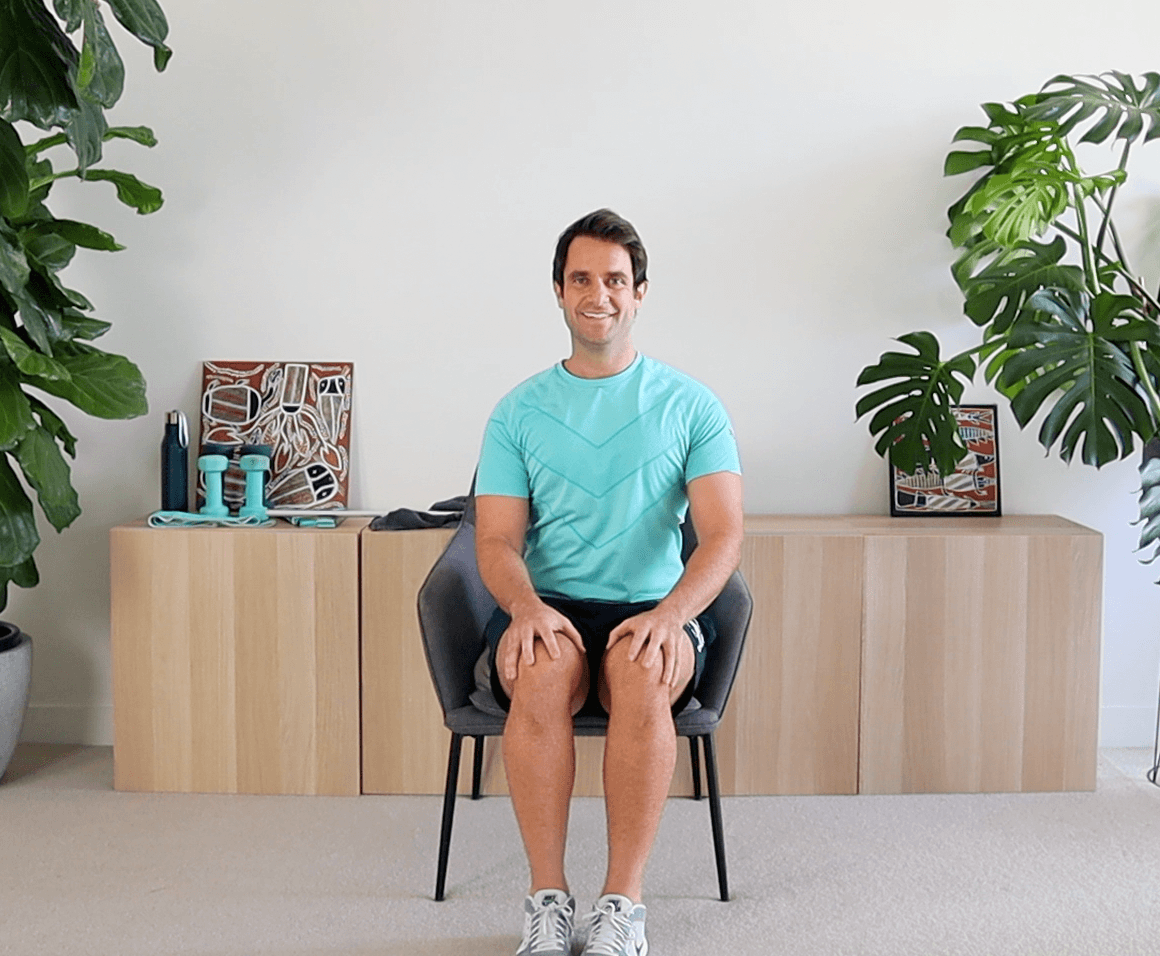THE 9 BEST EXERCISES FOR FROZEN SHOULDER FOR OLDER ADULTS
In this video, we cover the best exercises to help relieve pain and stiffness from Frozen Shoulder (Adhesive Capsulitis).
When you think of the shoulder joint, the joint you’d most probably be thinking of is the glenohumeral joint. The glenohumeral joint is the joint mainly responsible for moving the arm.
Adhesive capsulitis, or frozen shoulder, occurs when the shoulder capsule (the connective tissue surrounding the shoulder joint) becomes inflamed and therefore thicker which causes increased stiffness. “Itis” = Inflammation.
There are solutions to help with the pain and loss of range of motion with frozen shoulder, and certain exercises and stretches can be done to help with a more successful recovery.
Although these exercises are targeted for frozen shoulder, you can complete them for generalised stiffness of the shoulder also.
With these exercises, you want to stretch to the point of tension but not pain (a very small amount is ok).
Pre-Exercise Considerations
Before you jump into any new exercise routine, there's something super important to consider – chatting with your healthcare provider. Think of them as your personal coach. They'll help you figure out the best game plan and ensure you're doing exercises that are safe and effective for your specific situation.
Now, onto some tips for getting started safely with your exercises:
Warm-Up: Have you ever noticed how athletes warm up before a big game? That's because muscles perform better when they're warm. So, start with a gentle warm-up to get those shoulder muscles ready for action.
Start Slow: Think baby steps if you're just diving back into exercise. Start with simple, low-impact movements. You don't want to go from zero to hero and end up feeling sore or, worse, injured.
Listen to Your Body: Your body knows best. If something feels off or painful (and not in a 'good workout' kind of way), it's time to take a step back. Pain is your body's way of waving a red flag.
Stay Consistent: Consistency is key. It's like watering a plant – do it regularly, and you'll see it thrive. The same goes for your exercises. Regular movement can work wonders for easing that frozen shoulder.
Enjoy the Process: Last but not least, have some fun with it! Put on your favourite tunes, find a workout buddy, or exercise in your favourite part of the house. It's all about making the experience enjoyable.
There you have it – understanding Frozen Shoulder and getting ready to tackle it head-on with some safe exercises. Remember, you've got this, and your shoulders will thank you for it!
Top 9 Exercises for Frozen Shoulder in Seniors
For some more on frozen shoulder, including the exercises in written form.
In this video we cover:
Exercises For Frozen Shoulder - Adhesive Capsulitis exercises
Do your best and any questions ask below!
- Mike
Adhesive Capsulitis - The “Frozen Shoulder”
Adhesive capsulitis, more commonly known as “frozen shoulder”, is a condition characterised by pain, stiffness and an increased difficulty (or an inability) to lift the affected arm.
With frozen shoulder, what was once simple activities like over head, tucking in a shirt or doing up a bra can become impossible.
The good news is, frozen shoulder is not permanent. It does take some time (usually ranging from 9 months to 3 years) however, it will resolve itself and a full, functional recovery is usually made.
There are solutions to help with the pain and loss of range of motion with frozen shoulder.
In this article, we will take a look at what frozen shoulder is and what you can be doing to help this condition - including the best exercises (including a video) to help.
The Best Exercises For Frozen Shoulder
Adhesive capsulitis, more commonly known as “frozen shoulder”, is a condition characterised by pain, stiffness and an increased difficulty (or an inability) to lift the affected arm.
With frozen shoulder, what was once simple activities - like lifting something overhead, tucking in a shirt or doing up a bra can become very, very difficult.
The good news is, frozen shoulder is not permanent. It does take some time, usually ranging from 9 months to 3 years; however, it will resolve, and a full, functional recovery is usually made.
There are solutions to help with the pain and loss of range of motion with frozen shoulder, and certain exercises and stretches can be done to help with a more successful recovery.
In this article, we will look at what frozen shoulder is and the best exercises you can do (video included) to help with this condition.
CONTENTS OF ARTICLE:
A QUICK LOOK AT THE SHOULDER JOINT
Our shoulder is made up of three bones: Our clavicle (the collar bone), our scapula (the shoulder blade) and our humerus (the upper arm bone).
The three bones of the shoulder
Our shoulder also consists of two joints - the glenohumeral joint and the acromioclavicular joint.
When you think of the shoulder joint, the joint you’d most probably be thinking of is the glenohumeral joint. The glenohumeral joint is the joint mainly responsible for moving the arm.
The glenohumeral joint is a ball and socket joint. What that means is the end of the upper arm bone (the humerus) is shaped like a ball. The ball-shaped part of the humerus fits nicely into a shallow, cup-like socket of the scapula, known as the glenoid. Hence gleno (glenoid) - humeral (humerus) joint.
Where the humerus and scapula meet are covered with smooth, elastic cartilage, allowing for smooth movement.
The shoulder joint
The ball and socket mechanism allows for the variety of movements we can do with our arms. Compare this to the knee joint, which allows only a few movements.
The shoulder joint is encapsulated by connective tissue to protect and support it, known as the shoulder capsule.
WHAT IS ADHESIVE CAPSULITIS (FROZEN SHOULDER)
Adhesive capsulitis, or frozen shoulder - occurs when the shoulder capsule (the connective tissue surrounding the shoulder joint) becomes inflamed and therefore thicker which causes increased stiffness. “Itis” = Inflammation.
Frozen shoulder can arise spontaneously without a known cause, this is known as primary adhesive capsulitis or secondary which occurs with a known cause.
Secondary adhesive capsulitis can occur after a trauma/injury to the area, from a period of immobilisation, or a complication arising from shoulder surgery.
STAGES OF FROZEN SHOULDER
Adhesive capsulitis follows three stages:
The Freezing Stage - This is when the joint starts to stiffen.
In this stage, movement of the shoulder causes pain, and the range of motion of the shoulder begins to become limited.
The Frozen Stage - This is when the joint plateaus at its stiffest.
In this stage, pain eases. However, the shoulder stiffness increases, and it becomes more difficult to use the arm.
The Thawing Stage - This is when the shoulder starts to recover.
In this stage, the range of motion of the shoulder begins to improve.
RISK FACTORS FOR FROZEN SHOULDER
Frozen shoulder most commonly affects women over 40.
Other factors which increase the risk of a frozen shoulder is a long period of immobilisation of the shoulder joint. This could be from a past shoulder or arm injury, stroke, or recovery from surgery.
Certain diseases also increase the risk of frozen shoulder, including diabetes (as mentioned above), cardiovascular disease, hyper/hypothyroidism, Tuberculosis and Parkinson's disease.
SYMPTOMS OF FROZEN SHOULDER
The main symptoms of frozen shoulder are increased difficulty moving the arm, stiffness and pain. The pain usually worsens over time.
Common difficulties associated with frozen shoulder include:
Difficulty, or inability, reaching behind the back to put on a belt, tucking in a shirt, or doing up a bra.
Difficulty, or inability, reaching above shoulder height.
Difficulty, or inability, putting on a seatbelt or reaching to the side.
Inability grasping for something quickly.
Pain when sleeping or laying on your side.
One of the first indicators of frozen shoulder is commonly pain in the shoulder at night time.
NOTE: These symptoms may or may not be frozen shoulder, and a thorough assessment will be needed to determine your condition. If you have the above symptoms, see your Doctor or Physiotherapist.
WHAT TO DO FOR FORZEN SHOULDER FOR BETTER RECOVERY
Frozen shoulder usually resolves in nine months to three years.
In the initial stages, the freezing and the frozen stage, pain management may be required. Your doctor may recommend and prescribe anti-inflammatory medication and analgesia.
Analgesia can be combined with other methods of pain management.
Ice or heat can help with a flare-up of pain (IE you have overused the arm in some way aggravating the area).
Other pain management techniques could include gentle massage of the neck or shoulder or TENS (transcutaneous electrical stimulation), which is small, battery-operated device that reduces pain by sending small electrical signals.
To ensure a better recovery, it's important to also focus on restoring your body to the best health possible, which I touch on in many of my articles. Ways to do this include getting a better night's sleep, reducing stress and eating a healthier, nutrient-dense diet.
This will help improve the health of your body and decrease overall inflammation.
Additionally, exercises focused on improving the shoulder's range of motion and eventually strengthening the shoulder, and surrounding areas as pain levels improve should be the cornerstone of treatment.
We will now get to the best exercises for frozen shoulder and a video of exercises you can follow along to.
THE BEST EXERCISES FOR FROZEN SHOULDER - SHOULDER MOBILITY EXERCISES FOR SENIORS
With exercises for frozen shoulder, you want to stretch to the point of tension but not pain.
You do not want to aggravate the area, as aggressive stretching beyond the pain threshold can result in inferior outcomes, particularly in the early phase of the condition.
Using a heat pack on the area before doing these exercises will help warm up the area and loosen your muscles.
Note: Remember to consult your Doctor or Physiotherapist to ensure these exercises are appropriate for you. A physiotherapist can help you with specific exercises and apply manual treatments to assist in recovery. If these exercises cause an increase in pain or other symptoms, stop the exercise and make sure to speak to your Doctor or Physiotherapist.
NECK STRETCH
Neck muscles connect to the shoulder. It helps to stretch the neck muscles as this area can become tight and take on tension.
1. SIDE FLEXION NECK STRETCH
How To:
Sitting up tall in your chair, in good posture.
Bring your ear down to your shoulder as close as you can, keeping your face looking to the front.
You will feel the stretch in the opposite side of your neck.
You can increase the stretch by applying a gentle pressure with your hand on the side of your head.
Hold this position for 30 seconds and change sides.
SHOULDER RANGE OF MOTION EXERCISES
2. SHOULDER ROLLS
How To:
Sitting up tall in your chair, in good posture.
Bring your shoulders up back and around in a rolling motion
Complete this 5 times.
3. PENDULUMS
How To:
Standing next to a bench or behind a chair. Lean over as far as comfortable.
Relax your shoulders.
Allow your affected arm to hang down.
Swing the arm in a small circle — about a foot (30 centimetres) in diameter. You can hold a light weight (0.5-1kg) to increase the stretch.
Perform 5-10 revolutions in each direction.
Also swing your arm back and forth gently. Repeat 5-10 times.
As your symptoms improve, increase the diameter of your swing, but never force it.
4. ACTIVE ASSISTED SHOULDER FLEXION WITH WAND (LYING)
This exercise uses your unaffected arm or a stick (pipe or a piece of dowel - any light weight stick) for assistance.
How To:
Lay on a flat surface (the floor or a firm bed).
Keep your legs and arms straight.
Hold onto your stick in both hands, with your arm straight
Lift your arms vertically and backward as far as you comfortable can to the floor (towards your head and over) with the help of the unaffected arm.
Or, without the stick, use your unaffected arm to hold the elbow of the injured arm to help guide the arm towards the head or into the overhead movement.
Keep reaching until a stretch is felt.
Repeat 5-10 times.
6. ACTIVE ASSISTED SHOULDER EXTERNAL ROTATION WITH WAND (SEATED)
How To:
Similar to the previous exercise.
Sitting up tall in your chair with good posture, keep your elbows tucked in at your side at a 90-degree angle, holding onto your stick.
Rotate the affected arm out away from your body using the unaffected arm.
Repeat 5-10 times.
7b. WALL CRAWLS - FLEXION
How To:
Face a wall.
Reach out and touch the wall, at the height you are able to, with the fingertips of the affected arm.
Keeping your elbow slightly bent, slowly walk your fingers up the wall like a spider. Use your fingers, not your shoulder muscles.
Do this until you've raised your arm to shoulder level or as far as you comfortably can.
Slowly lower the arm (with the help of the good arm, if necessary) and repeat.
Perform this exercise 5-10 times.
7c. FINGER WALL CRAWL - ABDUCTION
How To:
As per the previous exercise, this time, face side on to the wall.
Reach out and touch the wall, at the height you are able to, with the fingertips of the affected arm.
Keeping your elbow slightly bent, slowly walk your fingers up the wall like a spider. Use your fingers, not your shoulder muscles.
Do this until you've raised your arm to shoulder level or as far as you comfortably can.
Slowly lower the arm and repeat.
Perform this exercise 5-10 times.
8. TOWEL STRETCH
The ability to place a hand behind the back becomes difficult with a frozen or stiff shoulder. This exercise helps stretch the shoulder for movements reaching behind the back.
How To:
Holding onto a rolled-up towel on the unaffected side, bring your arm over your head so the towel hangs behind you.
Now grab the other end of the towel behind your back with your affected arm.
Use your good arm to gently pull up, allowing the affected side to feel a bit of a stretch.
Hold for 10 seconds and repeat for 2-3 sets. Increase the time as you are able to.
9. POSTERIOR CAPSULE STRETCH
How To:
Sitting up tall in good posture.
Place your arm on your opposite shoulder, use your unaffected arm to lift your affected arm at the elbow, and bring it up and across your body.
Apply gentle pressure to stretch the shoulder.
Hold the stretch for 30 seconds.
SHOULDER STRENGTHENING EXERCISES
10. SCAPULA RETRACTIONS
This exercise gently stretches the front of the body (chest muscles) and is a basic strengthening exercise for the scapular muscles.
How To:
Sitting up tall in your chair, in good posture.
Squeeze your shoulder blades together and hold for 5 seconds.
Repeat for 5 times.
11. ISOMETRIC SHOULDER EXTERNAL ROTATION
This will help strengthen the shoulder muscles.
How To:
Sitting up tall in your chair, in good posture.
Keep the elbow of your affected arm tucked in at your side and at a 90-degree angle.
Now place your hand of the unaffected arm on the wrist of the affected arm
Apply a gentle pressure inwards on the unaffected arm and resist with the affected arm pushing out, keeping the arm in position.
Hold this for 5-10 seconds.
Repeat for 5 times.
FROZEN SHOULDER EXERCISES FOR SENIORS - SHOULDER RANGE OF MOTION EXERCISES (VIDEO)
DAILY SHOULDER EXERCISES VIDEO
SOURCES
1. Adhesive capsulitis of the shoulder: review of pathophysiology and current clinical treatments https://www.ncbi.nlm.nih.gov/pmc/articles/PMC5384535/2. Upper extremity: emphasis on frozen shoulder https://pubmed.ncbi.nlm.nih.gov/17141009/3. Physical therapy in the management of frozen shoulder. https://www.ncbi.nlm.nih.gov/pmc/articles/PMC5917053/
























